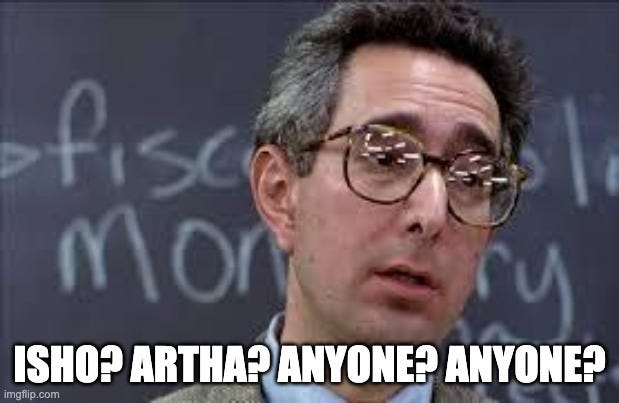The Alexandrian’s “RPGs: The Essential Reading List” provides a solid historical context, but it makes me cranky, and I’d go a different way. I’m not bagging on Alexander; I can appreciate his historical list. The reasoning is written out right there for you, and he said he’d take a survey/historical approach to construct it. Many other ‘essentials lists’ feel like folks phoning in the work, of stuff rehashed annually. My experience, however, is different.
If the question is:
“If you were teaching an intro-level college class on roleplaying game design, what would be the reading list?”
I’m interested in teaching what is possible in TTRPG game design—inspiring folks in my class to reach further, to push the envelope, dig deeper, and see RPGs' wild, vast potential. Here’s my read-and-play list. In this class, reading is not enough; we must get these games on the table for the play experience—that’s the weekly lab portion!
Minimum Viable RPGs
I think minimalist systems are the best place to start. They help us with: What is roleplaying? What does a minimal ‘game’ look like? And for the uninitiated, it is a low-friction way of experiencing. I'd start with these, though there are other, more minimalist systems than this.
Lasers & Feelings: A one-page RPG where players balance “lasers” (logic) and “feelings” (intuition) as they navigate sci-fi adventures. Its simplicity allows for rapid character creation and immediate play.
Fate Accelerated Edition (FAE): A streamlined take on the Fate system, using “approaches” instead of skills. Players define characters by how they act, not just what they know.
The 500-pound Dragon
As the most recognized TTRPG, Dungeons & Dragons 5E is a comprehensive intro to traditional, mainstream role-playing. It’s the perfect game to discuss what modern players expect from the play experience—what the game promises versus what the mechanics actually deliver. This is also the place to discuss House Rules as a fundamental part of RPG culture. Why do we use them? What purpose do they serve? Are they good?
Innovative Playstyles
Some games break the mold of expectations and offer fresh perspectives on play, often building on and innovating on what has come before, like the Red Hot Chili Peppers’ Higher Ground or Roller Coaster covers.
Blades in the Dark: Set in a haunted, industrial-fantasy city, this game focuses on heists and crew dynamics. Its unique mechanics include a “stress” system, flashbacks as a gameable resource, and planning as a dice roll.
Spire: The City Must Fall: In a mile-high city ruled by oppressive high elves, players use a “Resistance System” to resolve actions and navigate the fallout of stress and rebellion.
Super Heavy Dense Systems
And then there are the massive, super heavy bodies of crunch and customization; these systems provide depth and complexity to nerd out on and require system mastery skills.
GURPS (Generic Universal RolePlaying System): Designed to accommodate any genre, GURPS offers a point-based character creation system and a vast array of supplements, allowing for detailed customization and world-building.
Burning Wheel: A System of a core hub system and various sub-systems for resolving arguments, magic, injuries, at least three kinds of fighting. And an advancement system that promotes getting better at what you use.
The Roads Less Traveled
Games that challenge RPG conventions create unique game experiences.
Amber Diceless Roleplaying: No dice! This system relies on comparative stats and narrative choices, emphasizing creativity and negotiation.
Microscope: A GM-less game where players collaboratively build entire histories and worlds—perfect for macro-level storytelling, not just character arcs.
Immersive and Unique Worlds
Some RPGs stand out thanks to imaginative, deeply developed settings.
Skyrealms of Jorune: Set on the alien planet Jorune, this science-fantasy RPG features floating islands (skyrealms) suspended by mysterious crystals and an ambient energy called Isho. Players navigate a world where humans and various alien species coexist, exploring ancient technologies and mystical energies.
Talislanta: Renowned for its slogan "No Elves," Talislanta offers a high-fantasy setting devoid of traditional fantasy races. Instead, it presents diverse cultures and species across a continent rich in magic and history. The game's vivid art and imaginative world-building provide a fresh take on fantasy role-playing.
Emotionally Charged Narratives
Certain RPGs delve into profound and often challenging subject matter, offering players experiences that are thought-provoking, emotionally deep, and, yes, political.
Steal Away Jordan: This game invites players to embody enslaved individuals in 19th-century America, focusing on their struggles, resilience, and pursuit of freedom. Inspired by slave narratives, it uses the RPG medium to explore the harsh realities of slavery.
Carry. a game about war. Set during the Vietnam War, this short-form game centers on a squad of Marines grappling with the psychological burdens of combat. Drawing inspiration from works like The Things They Carried, it offers a poignant exploration of the human cost of war.
High Concept and BIG Games
For those BIG concept experiences, these games provide a platform for deep, high-commitment experiences.
Noblis is a diceless RPG in which players assume the roles of powerful entities embodying abstract concepts like Death, Time, or Communication. The game emphasizes narrative control and explores themes of divinity, responsibility, and the nature of reality.
Ars Magica: Set in a mythic version of medieval Europe, players take on the roles of magi belonging to the Order of Hermes. The game is renowned for its intricate magic system, troupe-style play, and emphasis on long-term character and covenant development.
This curated path offers a practical approach to understanding the vast landscape of TRPGs. Players can discover the various styles and mechanics of what is already possible by starting with minimalist systems and progressively exploring more complex and unconventional games.
Let me know what you think. What’s your class syllabus look like?


